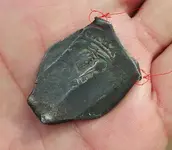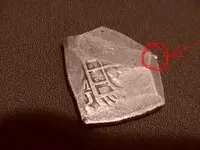Born2Dtect said:
I have never seen a found cut cob reale with that sharp an edge or the multiple angles your shows. The only way it is real is if was freshly dropped out of someones collection. How?, I would not know. Also it should read high on the silver scale. I would bet it does not. Take it to a coin dealer, they will tell you for sure.Ed D.
That is what started the identification problem.



A coin dealer, who I also considered a friend, told me that it appeared to be a cast silver fake. He didnt even want to buy it. That was back in the ealy 80's, I believe. Good thing, I guess, because i kept it in my junk box all these years. I believe now that IT IS REAL and you would have to show me proof for me to think otherwise. The link you sent me about someone seeding the beach with fake cobs was interesting, but does not look anything like mine. Besides mine is silver. Those beach seeds were obvious worthless pot metal souvenirs. If my cob is counterfeit, it is a very good silver one. Thanks for trying to help anyway.









 )
)

